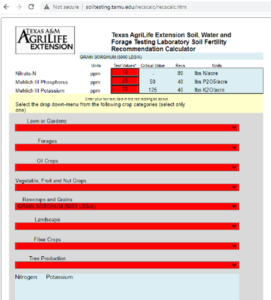Dr. Calvin Trostle, Extension Agronomy/TAMU Dept. of Soil & Crop Sciences, Lubbock, (806) 746-6101, ctrostle@ag.tamu.edu
Dr. Tony Provin, Extension Soil Testing,/TAMU Dept. of Soil & Crop Sciences, College Station, (979) 845-4816, t-provin@tamu.edu
May 4, 2021
Texas farmers have many choices for laboratories conducting their soil analyses. If you work with a fertilizer dealer, they may collect your soil samples, pay for analysis, and draw from the information to make recommendations. This is fine, just know there is a possible conflict of interest (sales). If someone does your soil sampling for you ask for a copy of the soil test results.
There are at least five major labs in Texas that offer agricultural soil testing. Texas A&M AgriLife is one (http://soiltesting.tamu.edu). You can be assured that any soil test recommendations you receive from Texas A&M AgriLife for major crops like grain sorghum or cotton are based on research in Texas soils and Texas conditions to determine nutrient response curves. (Many minor acreage crops will receive recommendations but based on estimates of nutrient requirements where research is absent. Additionally, strong collaboration exist between Texas A&M AgriLife and the cross border land grant universities who routinely compare, contrast and facilitate research supporting jointly adopted recommendations.)
For N/P2O5/K2O, i.e. nitrogen/phosphate/potash, Texas growers may be able to take the soil test value (not the recommendations) from another lab IF the other lab uses the “Mehlich-III” soil extraction (in this case, for P and K) procedure. Ask the other lab if they use Mehlich-III by ICP and nitrate-N by cadmium reduction). These methods are actually the most common methods used in the United States. If another lab uses a different procedure from Mehlich-III (by ICP) then what we tell you here does not apply. You will get the wrong results.
If you meet the Mehlich-III and nitrate-N criteria, then access the online Texas A&M AgriLife Soil Testing Lab’s calculator at http://soiltesting.tamu.edu/recscalc/recscalc.htm See the figure below for what this link looks like. In this example, I entered data from a soil test report for a 5,000 lb./A grain sorghum crop.
In this example I had soil test values of:
- 10 ppm nitrate-nitrogen (nitrate-N)
- 25 ppm P by Mehlich-III
- 70 ppm K by Mehlich-III
We entered these values at the top (see figure). You see “Critical Value” listed for P and K. This is the value beyond which no additional economic response to the nutrient is expected. If your soil test value is above the critical value, the recommendation will be 0 lbs/acre.
From the drop-down menu there are eight different categories of crops or plants for which fertilizer recommendations may be obtained. The major crops like grain sorghum will also have different yields.
you can choose from to represent your production conditions and yield goal. This helps fine-tune the possible fertilizer recommendations.
In this example we clicked on “Row Crops and Grains” then scrolled down to find the grain sorghum yield goal I wanted (5,000 lbs./A). Click on it. Now, the entered values of N, P, and K will calculate a recommended level of fertilizer, if needed, for each nutrient.
In this case the soil test data and yield goal combine to recommend:
- 80 lbs. of N per acre (no suggestion on whether to split apply)
- 40 lbs. of P2O5/acre fertilizer equivalent
- 40 lbs. of K2O/acre fertilizer equivalent
It is up to you then to decide what you want to apply. More (hopefully not much more) or less (hopefully not much less). You can also compare Texas A&M recommendations to that from another state or laboratory (if you requested recs). If different it is up to you to decide what you are comfortable with.
Remember: What is the key to using this online calculator for N/P/K? The data you have must use the Mehlich-III extraction procedure.
Your Soil Samples and Out-of-State Test Labs
Some Texas farmers send their soil samples out of state. The reason could be quick turnaround time, lower cost, or their fertilizer dealer has an arrangement for bulk pricing. How do you know if you send a Nueces Co. soil sample for grain sorghum to Mississippi you will get an appropriate recommendation? Or a cotton soil sample from the Texas High Plains goes to a lab in Nebraska?—they don’t grow cotton in Nebraska! What nutrient research has been loaded in their algorithm to calculate what you may need?
If you are sending your samples out of state, call the lab and ask them what research and data they use to make fertilizer recommendations in Texas. If fortunate they have loaded Texas A&M info. into their database to use on samples with a Texas zip code. If not, then ask how they make their recommendations. This is essential. Most Texas growers have not thought to ask.
There are about a dozen online calculators from Texas A&M AgriLife at http://soiltesting.tamu.edu/webpages/calculator.html There are many uses. A few of these might now be an app on your smartphone.
If you have questions about soil testing and nutrients for crops on your Texas farm, you regional Extension agronomist or the Soil Testing Lab directly.
